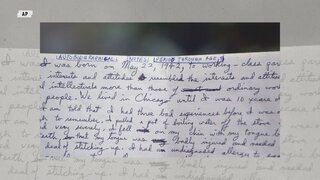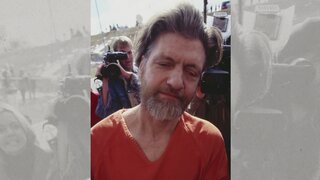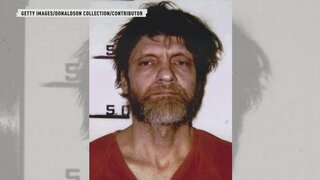Create a free profile to get unlimited access to exclusive videos, breaking news, sweepstakes, and more!
Who Were The Victims Of Unabomber Ted Kaczynski's Acts Of Terror?
Between 1978 and 1995, Ted Kaczynski killed three people and injured 23 more in a nationwide bombing campaign that targeted people involved with modern technology.
The Unabomber was infamous for his reign of terror across the United States between 1978 and 1995, when he would send homemade mail bombs across the country — claiming the lives of three people, injuring dozens more and forever changing the lives of countless people across America.
A mathematic prodigy and social recluse, Ted Kaczynski became so enraged as he watched the wilderness around his Montana cabin be destroyed by so-called titans of industry, especially large-scale mechanical companies specializing in lumber and technology.
He then came to believe there was only one logical way to stop it: by hurting representatives of modern technology he felt ruined his lifestyle. By hurting the people behind these corporations, Kaczynski thought he could put an end to the large-scale organizations he believed were ruining humanity and the world around them.
RELATED: Why Did Unabomber Ted Kaczynski Cut His Brother David Out Of His Life?
But who specifically did he target in his numerous attacks? As Kaczynski himself states on tape in the new Netflix docuseries Unabomber — In His Own Words, he went after figureheads, large and small, of the digital revolution as a mode of "revenge" and method to save humanity from itself.
Kaczynski's first victim on May 25, 1978 was Terry Marker, a police officer on-duty at Northwestern University. The package was directed for Buckley Crist, a professor of materials engineering at the university, with a return label bearing the address of his office on campus. Crist, who knew he had not sent a package to its listed destination in Chicago, contacted campus police. As Marker investigated, the bomb exploded. He sustained minor injuries to his left hand.
"I never knew the guy, I never met him and I have no idea why he involved me," Crist said of Kaczynski in comments to the New York Post.
Two years later, on May 9, 1979, another package was sent to Northwestern. This time, graduate student John Harris was the victim.
"There was a cigar box on the table outside my office," Harris recalled in a 1996 interview with the the Champaign News-Gazette. "I picked it up, intending to put some pens and pencils inside. It turned out to be a bomb, which did not explode. It had a detonator that went off."
He remembers seeing a bright flash without sound, and aside from some superficial burns he was unharmed.
"It scared the hell out of me at the time," Harris told the Chicago Tribune when Kaczynski entered a plea deal. "But I'm generally opposed to the death penalty. I also think that Kaczynski was crazy."
Afterwards, Kaczynski set his sights on airline travel. On Nov. 15, 1979, he upped the ante and placed a bomb in the cargo hold of American Airlines Flight 444. The plane was a Boeing 727 model flying from Chicago to Washington, D.C. The bomb caused "a sucking explosion and a loss of pressure" as reported by The Washington Post at the time, and resulted in large quantities of smoke filling the passenger cabin.
The pilots made an emergency landing at Dulles International Airport, and 12 passengers were treated for smoke inhalation. A faulty timing mechanism prevented the bomb from exploding properly, but TIME estimated that if had it worked the way it was designed, passengers would have met a much deadlier fate.
Seven months later on June 10, 1980, a parcel was sent to the home of United Airlines president Percy Wood at his home in Lake Forest, Illinois. The bomb was rigged inside the book Ice Brothers by Sloan Wilson. He suffered from serious burns and cuts over much of his body once the bomb went off.
"I've thought about it a lot but I still don't know why it happened," he said to The Chicago Tribune in the aftermath. "I've never heard the guy's name. I never saw him before."
Indeed, Kaczynski knew few of his victims personally. His goal, as outlined in his manifesto, was to use the extreme bombings to attract attention to the erosion of human freedom and dignity at the hands of modern technology.
After a failed attempt to bomb a business classroom at the University of Utah in October 1981, Kaczynski tried again on May 5, 1982, mailing a bomb to Patrick C. Fischer, a computer science professor at Vanderbilt University in Nashville. His secretary Janet Smith opened the package, and was hospitalized for three weeks as a result of the attack. She never spoke of it again, even after recovering
"She made a full recovery, but it was very traumatic for her," Fischer told The Washington Post in 1996. "She'd just as soon forget about it."
Fischer was somewhat relieved when prosecutors agreed to a plea deal.
"The trial would have been a circus," Fischer told the Chicago Tribune. "The most important thing is that he's put away and kept away for life because he's still dangerous."
Two months later on July 2, Diogenes J. Angelakos, a pioneer in the field of microwaves and electromagnetic waves, sustained injuries to his face and right hand after picking up an unmarked item in the faculty common room at the University of California, Berkeley (UCB).
Angelakos died in 1997.
Kaczynski struck UCB again on May 15, 1985. Graduate student John Hauser, who dreamt of becoming an astronaut according to The Chicago Tribune, lost four fingers and severed a major artery in his right arm. Interestingly, it was Angelakos who responded to the scene first and secured a makeshift tourniquet around his arm before medical personnel arrived.
Kaczynski's plot to bomb The Boeing Company in Auburn, Washington a month later was thwarted, and another bomb delivered to a Michigan residence left psychology professor James V. McConnell and research assistant Nicklaus Suino with temporary hearing loss and minor shrapnel wounds, respectively. But before the year was out, on Dec. 11, he achieved the first fatality in his terror spree, killing computer store owner Hugh Scrutton in California.
Detailed as "Experiment 97" in his written account of the killing, Kaczynski thought that it was an "excellent" and "humane way to eliminate somebody," hypothesizing that Scrutton "probably never felt a thing."
As Kaczynski grew more fluent in bomb making, the repercussions on his victims became more dire. Gary Wright, another computer store owner in Utah's Salt Lake City area, was left with severe nerve damage to his left arm on Feb. 20, 1987; geneticist and Down syndrome researcher Charles Epstein lost three fingers and part of his hearing on June 22, 1993; and computer science professor David Gelernter lost his right hand and sustained major damage to his right eye on June 24 of the same year.
RELATED: What Is The Origin Of Ted Kaczynski's Infamous Nickname 'The Unabomber'?
Thomas J. Mosser, an executive at public relations and communications firm Burson-Marsteller, died upon opening a package sent to his New Jersey home on Dec. 10, 1994. In a letter to The New York Times, Kaczynski said he "blew up Thomas Mosser because ... Burston-Marsteller helped Exxon clean up its public image after the Exxon Valdez incident [in 1989]." He added that the company's primary objective was "manipulating people's attitudes."
Kaczynski's final victim, Gilbert Brent Murray, died upon opening a bomb sent to his office in California. Murray was the president of the California Forestry Association, the state's timber industry lobby organization. While not made explicitly clear at the time, the San Francisco Gate confirmed that Murray "was not the intended addressee."
In June of 1995, Kaczynski sent his 35,000 word manifesto "Industrial Society and Its Future" to both The Washington Post and The New York Times, both of which were actively reporting on the Unabomber case. He threatened to bomb an unspecified location if his writing was not published. He would continue to make threats however, as later in the month he sent a letter to The San Francisco Chronicle threatening to attack a flight out of Los Angeles.
After much debate, both news outlets published the manifesto at the request of Attorney General Janet Reno and the FBI on Sept. 19, 1995.
Kaczynski was ultimately caught when his brother David tipped off the FBI that the tone of the recently published manifesto was similar to the previous writings of Ted Kaczynski. He was arrested in 1996 and entered into a plea deal in 1998 under which he was sentenced to life in prison without the possibility of parole. He is was held in a federal maximum security facility in Colorado. He later died of a suspected suicide in June 2023, the Associated Press reported.
But for many of his surviving victims, they lack true clarity on why the Unabomber chose them to be victims.
"Why me?" Fischer asked in the 1996 Washington Post article prior to his 2011 death. "Why was I selected?"
(This article was originally published on February 22, 2020. It was updated on June 12, 2023.)































